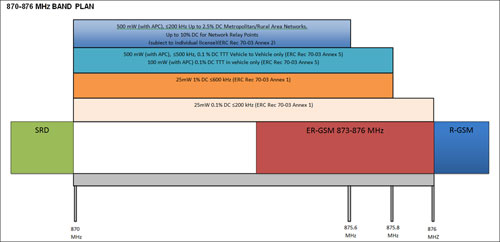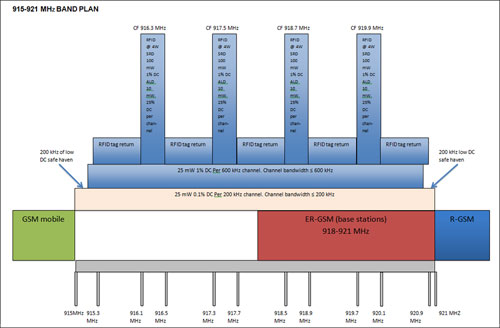As the seemingly insatiable appetite for spectrum for wireless broadband continues apace—supported by the European Union’s spectrum policy program that calls for the 1200 MHz band to be made available—some of our more moderate spectrum users are also ripe for growth. A wide range of highly valuable uses of spectrum are to be found squeezed into a few relatively narrow bands operating as (typically unlicensed) short-range devices (SRD). These devices have a huge significance in our daily lives, whether as assistance for the hearing-impaired, or in bringing down the costs of supermarket goods, or as part of making an intruder alarm system affordable—to give just three examples.
The European Conference of Postal and Telecommunications Administrations (CEPT), an organization comprising policy makers and regulators from 48 nations across Europe, is working to improve the efficiency of these bands, and to widen the possibilities for accessing them. This is based on applying a step-by-step, evidence-based process for enabling more generic conditions to be applied to wider spectrum bands than before, instead of slicing the available frequencies into narrow bandwidths for niche applications.

A Major Milestone, Driven by Demand
The CEPT has now reached a milestone in the development and management of frequencies in the favored range just below 1 GHz for RFID and a wide variety of SRD applications, with the creation of a new roadmap that paves the way for a major upgrade of 19 MHz of spectrum. At present, the range of 863 to 870 MHz is used extensively for SRDs. However, these ranges are filling up quickly, and a lot of new applications are anticipated, as noted in ECC Report 182—a survey discussing the use of the 863 to 870 MHz frequency band—and by the European Telecommunication Standards Institute (ETSI).
These applications include rising spectrum demands for generic SRD, ultrahigh-frequency (UHF) RFID, home automation and submetering, automotive SRD, smart meters and smart grids, metropolitan mesh machine networks (M3N) applications, alarm and social alarm systems, and assistive-listening devices (including hearing aids). In addition to capacity constraints, the bandwidth of the existing plans has had other impacts; for example, a wider bandwidth for individual RFID devices will improve their performance and function. With mesh machine networks, the required bandwidth of the systems would not fit into the existing narrow bandwidths currently available.
Against this background, we need to take into account two significant considerations. First, on the American continent, the 902 to 928 MHz band is allocated to industrial, scientific and medical (ISM) uses, which is a convenient basis for using SRDs, and a lot of equipment is thus being developed to operate within this range. For Europe, as part of the ITU-R Region 1, no ISM band was identified at the World Administrative Radio Conference (WARC-79) in 1979 in this portion of the spectrum. Second, there are two significant adjacent frequency ranges that are seriously underutilized in many European countries: namely, 870 to 876 MHz and 915 to 921 MHz. These two bands had been prepared for use by private mobile radio systems, but that development has seen very little take-up.
With the rapid growth in applications for both SRDs and RFID, the industry had recognized an urgent need for additional spectrum at UHF. They identified that the dual bands of 870 to 876 MHz and 915 to 921 MHz, originally allocated to Professional Mobile Radio (PMR) and Public Access Mobile Radio (PAMR)—for example, the TETRA technology used by European government and emergency services agencies—were effectively unused. ETSI proposed to the CEPT that the 870 to 876 MHz be assigned to SRDs. The Frequency Management Working Group (WGFM) of CEPT’s Electronic Communications Committee (ECC) has agreed that the band will be predominantly occupied by SRDs at 25 milliwatts (mW) and a duty cycle (DC) of up to 1 percent in bands of up to 600 kHz. However, some vehicle applications are permitted to operate at up to 500 mW at a DC of 0.1 percent. Additionally, Metropolitan Area Networks may also operate at power levels of 500 mW with a DC up to 10 percent for their Network Relay Points, though these may be subject to individual licenses.
The upper band will be occupied by RFID systems, with interrogators operating at power levels up to 4W ERP in four channels of 400 kHz, equally spaced at 1.2 MHz. Tags should respond in the low-power channels not used by the interrogators. SRDs (at up to 100 mW and 1 percent DC) and assisted-listening devices (at 10 mW and 25 percent DC) are permitted to share the high-power interrogator channels with RFID. SRDs are permitted to occupy the low-power channels at duty cycles of less than 1 percent and power levels not exceeding 25 mW.
The availability of this additional spectrum will bring considerable benefits. In the case of SRDs, it will provide an opportunity to introduce some important new applications, such as smart metering and new uses in the automotive industry. More importantly, it will provide the additional capacity necessary for the continued expansion of traditional applications, such as home automation, alarms, telemetry and general-purpose SRDs.
For RFID, the principal benefits will be the ability to operate at higher power and faster data rates. It will allow RFID to meet the needs of new applications previously not possible. A further important benefit is that RFID will be able to operate in the same band as that used by all major trading nations.
ECC Instruments and Conclusions
ECC Report 200 provides the background and conclusions to a comprehensive set of coexistence studies in these underutilized UHF bands in Europe. Some of these used the ECC’s SEAMCAT analysis tool, developed and maintained by the ECO, in Copenhagen. The related ECC Report 189, prepared by the ECC’s SRD Maintenance Group, used these conclusions to define recommended regulatory parameters for SRDs. Finally, Recommendation 70-03 was agreed upon in February 2014, with new entries in the 870 to 876 and 915 to 921 MHz frequency bands. Report 189 recognizes that although the bands are underutilized for PMR, there are significant existing governmental services with access to part of the new frequencies in several countries that would need protection in the future, at the discretion of the relevant national administrations.
The review included an audit of these existing and planned uses, which revealed not only some of the previously well-known military tactical systems, but also some new uses, such as remote control of unmanned aircraft (UAV). Several other countries anticipate a need to use the spectrum at some specific locations for an extension of the existing GSM-R bands. ECC studies have covered this utilization to provide a solution for spectrum-sharing with GSM-R.


ECC Report 200 also describes the use of network access points and relay points forming part of metropolitan area mesh networks, such as for utilities or other applications, for the purpose of data acquisition.
This particular approach provides a good example of the CEPT’s use of “soft harmonization,” in which existing services remain protected to the extent that national administrations deem it necessary, while providing the opportunity for the harmonized development of new services in the majority of European countries. The success of the ERC Recommendation 70-03 owes much to its soft harmonization approach, which is quicker to set up than a more rigid, centralized harmonization process, by which the measures needed to deal with important but limited incumbent interest can block or delay the process at the European level.
As a result of the CEPT’s decision to make additional spectrum available, ETSI will introduce revisions to the standards EN 300 220 (for SRDs) and EN 302 208 (for UHF RFID). It is hoped that the new versions of the standards will become available next year.
Thomas Weber ([email protected]) works in the European Communications Office‘s spectrum management department and is chairman of the CEPT’s SRD Maintenance Group, charged with the task of examining the need for additional spectrum for RFID and short-range devices.

